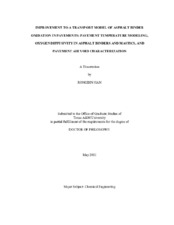| dc.description.abstract | Although evidence is mounting that asphalt binder oxidizes in pavements, and that oxidation and subsequent hardening of asphalt binder has a profound effect on pavement durability, important implementation issues remain to be better understood. Quantitative assessment of asphalt binder oxidation for a given pavement is a very important, but complex issue.
In this dissertation, a fundamentals-based oxygen transport and reaction model was developed to assess quantitative asphalt binder oxidation in pavements. In this model, oxygen transport and reaction were described mathematically as two interlinked steps: 1) diffusion and/or flow of oxygen from the atmosphere above the pavement into the interconnected air voids in the pavement; and 2) diffusion of oxygen from those air voids into the adjoining asphalt-aggregate matrix where it reacts with the asphalt binder.
Because such a model calculation depends extensively on accurately representing pavement temperature, understanding oxygen diffusivity in asphalt binders and mastics, and characterizing air voids in pavements, these key model elements were studied in turn. Hourly pavement temperatures were calculated with an improved one-dimensional heat transfer model, coupled with methods to obtain model-required climate data from available databases and optimization of site-specific pavement parameters nationwide; oxygen diffusivity in binders was determined based on laboratory oxidation experiments in binder films of known reaction kinetics by comparing the oxidation rates at the binder surface and at a solid-binder interface at the film depth. The effect of aggregate filler on oxygen diffusivity also was quantified, and air voids in pavements were characterized using X-ray computed tomography (X-ray CT) and image processing techniques. From these imaging techniques, three pavement air void properties, radius of each air void (r), number of air voids (N), and average shell distance between two air voids (rNFB) were obtained to use as model inputs in the asphalt binder oxidation model.
Then, by incorporating these model element improvements into the oxygen transport and reaction model, asphalt binder oxidation rates for a number of Texas and Minnesota pavements were calculated. In parallel, field oxidation rates were measured for these corresponding pavement sites and compared to the model calculations. In general, there was a close match between the model calculations and field measurements, suggesting that the model captures the most critical elements that affect asphalt binder oxidation in pavements.
This model will be used to estimate the rate of asphalt binder oxidation in pavements as a first step to predicting pavement performance, and ultimately, to improve pavement design protocols and pavement maintenance scheduling. | en |


